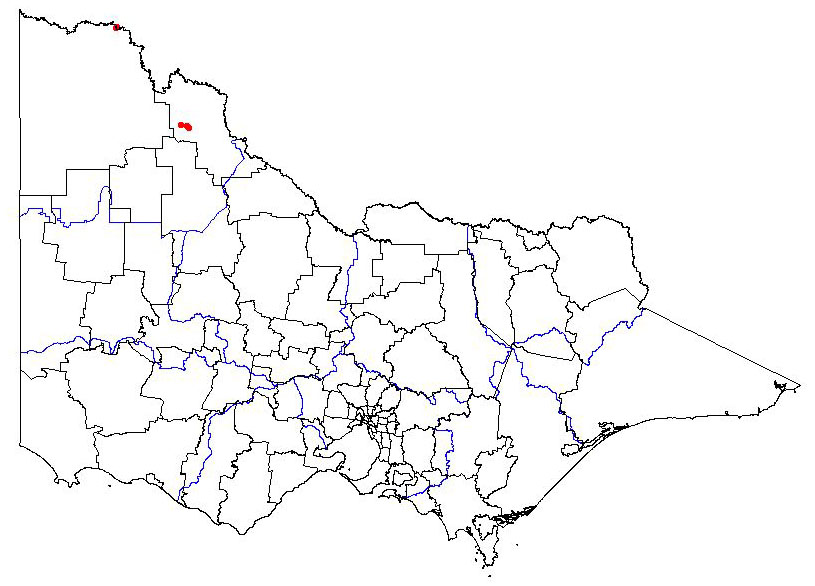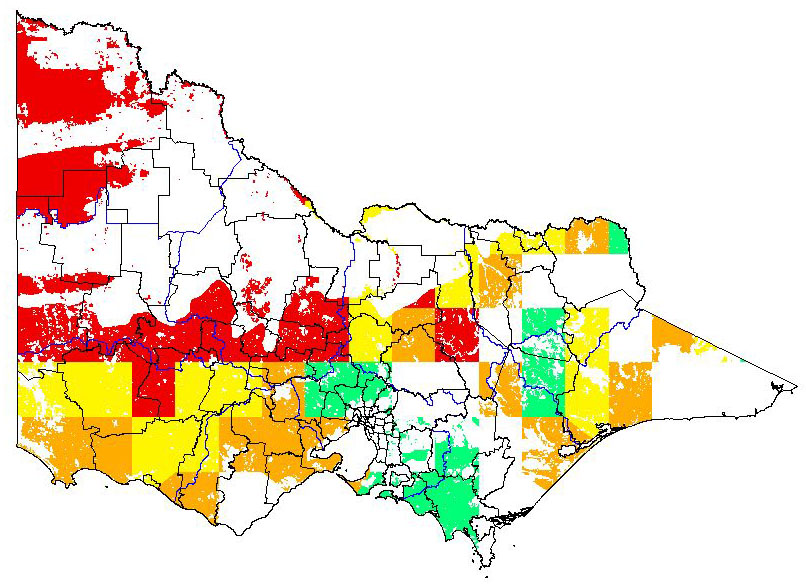Devil's rope (Cylindropuntia imbricata)
Present distribution
|  Map showing the present distribution of this weed. | ||||
| Habitat: Native to North America. Reported in various grasslands and woodlands to 2200m. | |||||
Potential distribution
Potential distribution produced from CLIMATE modelling refined by applying suitable landuse and vegetation type overlays with CMA boundaries
| Map Overlays Used Land Use: Pasture dryland Broad vegetation types Coastal scrubs and grassland; coastal grassy woodland; lowland forest; box ironbark forest; inland slopes and plains; sedge rich woodland; dry foothills forest; montane dry woodland; sub-alpine woodland; grassland; plains grassy woodland; herb-rich woodland; sub-alpine grassy woodland; montane grassy woodland; riverine grassy woodland; rainshadow woodland; mallee; mallee heath; boinka-raak; mallee woodland; wimmera / mallee woodland Colours indicate possibility of Cylindropuntia imbricata infesting these areas. In the non-coloured areas the plant is unlikely to establish as the climate, soil or landuse is not presently suitable. | 
|
Impact
QUESTION | COMMENTS | RATING | CONFIDENCE |
| Social | |||
| 1. Restrict human access? | Can grow to 3m and has spines (Hubert 1980), would be an impediment. | m | m |
| 2. Reduce tourism? | May have some negative influence on the aesthetics of an area. | ml | m |
| 3. Injurious to people? | Does have spines (Hubert 1980). | mh | mh |
| 4. Damage to cultural sites? | No reported structural damage may have a negative influence on the aesthetics. | ml | m |
| Abiotic | |||
| 5. Impact flow? | Terrestrial species | l | m |
| 6. Impact water quality? | Terrestrial species | l | m |
| 7. Increase soil erosion? | Reduces grazing pressure on an area, by restricting the movement of grazing species, and protecting the grasses/herbs in the immediate vacinity of its spines (Pieper 1971), therefore increasing the ground cover and reducing soil exposed to erosion. | l | m |
| 8. Reduce biomass? | Apparent lack of competition between it and the grasses has been reported also that C.imbricata, may improve the microclimate for grasses, while also protecting them from over grazing increasing net biomass (Mueller, Shoop & Laycock 1994 and Pieper 1971). | l | m |
| 9. Change fire regime? | If an increase in biomass does eventuate from the presence of C.imbricata, this increase in fire intensity would not be persistent as the cactus population left exposed after the fire would be reduced by herbiovry due to its now lack of spines (Bunting, Wright & Neuenschwander 1980). | l | m |
| Community Habitat | |||
| 10. Impact on composition (a) high value EVC | EVC= Plains Savannah (E); CMA= Wimmera; Bioreg= Lowan Mallee; VH CLIMATE potential. Competitive species in shrub layer, can alter conditions for grass/herb layer Major displacement of dominant sp. within a layer, and alter species composition of another layer. | mh | mh |
| (b) medium value EVC | EVC= Semi-arid Woodland (D); CMA= Wimmera; Bioreg= Lowan Mallee; VH CLIMATE potential. Competitive species in shrub layer, can alter conditions for grass/herb layer Major displacement of dominant sp. within a layer, and alter species composition of another layer. | mh | mh |
| (c) low value EVC | EVC= Lowan Sands Mallee (LC); CMA= Wimmera; Bioreg= Lowan Mallee; VH CLIMATE potential. Competitive species in shrub layer, can alter conditions for grass/herb layer Major displacement of dominant sp. within a layer, and alter species composition of another layer. | mh | mh |
| 11. Impact on structure? | In a grassland it creates a shrub layer and reportedly may alter the microclimate for the grass and herb layer (Pieper 1971). | ml | m |
| 12. Effect on threatened flora? | No specific data, may protect species sensitive to grazing. | m | ml |
| Fauna | |||
| 13. Effect on threatened fauna? | No specific data. | mh | l |
| 14. Effect on non-threatened fauna? | If invades grassland creates a vegetation layer that previously didn't exist. | l | m |
| 15. Benefits fauna? | May be a food source during drought (Endecott etal 2005). | mh | m |
| 16. Injurious to fauna? | Does have spines (Hubert 1980). | mh | m |
| Pest Animal | |||
| 17. Food source to pests? | Cactus species reportadly eaten by goats. | ml | m |
| 18. Provides harbor? | No more than another shrub species. | m | ml |
| Agriculture | |||
| 19. Impact yield? | Conflicting data on its impact on the net herbage yield of an area as fodder for stock. Also may be used itself as a fodder source during drought, but its use is cautioned (Endecott etal 2005, Pieper 1971 and Pieper, Rea & Fraser 1974). | ml | m |
| 20. Impact quality? | No specific data however if used as a fodder source may have a negative effect on stock (Endecott etal 2005). | l | m |
| 21. Affect land value? | If control viewed as necessary, may have negative effect on land value. | m | ml |
| 22. Change land use? | A pest of pastoral country can't really be further downgraded. | ml | m |
| 23. Increase harvest costs? | If restrict the movement of stock may increase mustering times. | mh | m |
| 24. Disease host/vector? | Not reported. | l | m |
Invasive
QUESTION | COMMENTS | RATING | CONFIDENCE |
| Establishment | |||
| 1. Germination requirements? | No data specified for seed germination of this species, presumed like other opuntia species requiring a sufficient quantity of water in the growing season, also vegetative propagules of opuntia sp. only require sufficient water to set root | h | ml |
| 2. Establishment requirements? | Passive dispersal by stock and wildlife is that gaps and open spaces are created for the species to fill, therefore may require bare ground for establishment (Allen etal 1991). | ml | m |
| 3. How much disturbance is required? | Invades grassland | mh | m |
| Growth/Competitive | |||
| 4. Life form? | Tree-like cactus, growing to 3m (other) (Hubert 1980). | l | m |
| 5. Allelopathic properties? | None described. | l | m |
| 6. Tolerates herb pressure? | Has been used as emergency stock feed in New Mexico for more than 100 years. However due to its spines it first required to be singed (Endecott etal 2005). | mh | mh |
| 7. Normal growth rate? | No specific data but being tree like would at least be average for opuntia species. | mh | m |
| 8. Stress tolerance to frost, drought, w/logg, sal. etc? | Can survive fire but is left exposed to herbivory post-fire leading to up to 100% mortality (Bunting, Wright & Neuenschwander 1980). Reportadly its native range includes areas that experience an average January temperature of -1C, therefore it can withstand temperature below 0C (Frost tolerant) (Kinraide 1978). Used as emergency feed during a drought can therefore tolerate of drought (Endecott etal 2005). | mh | mh |
| Reproduction | |||
| 9. Reproductive system | Produces fruit that contain seeds, broken segments can also reproduce vegetatively (Allen etal 1991). | h | mh |
| 10. Number of propagules produced? | Reported to set numerous seeds, also a 3m tall plant with branches could be broken up into many viable propagules (McFarland, Kevan & Lane 1989). | mh | m |
| 11. Propagule longevity? | Not specified. | m | l |
| 12. Reproductive period? | No specific data for this species, however the majority of other cactace sp. live longer than 10 years, and can reproduce vegetatively during this time. | h | m |
| 13. Time to reproductive maturity? | Can reproduce vegetatively within its first year of growth. | h | m |
| Dispersal | |||
| 14. Number of mechanisms? | More than just passive dispersal (McFarland, Kevan & Lane 1989). | m | m |
| 15. How far do they disperse? | Unknown | m | l |
References
Allen. L.J.S., Allen. E.J., Kunst. C.R.G. & Sosebee. R.E. (1991) A diffusion model for dispersal of Opuntia imbricata (Cholla) on rangeland. Journal of ecology. 79: 1123-1135.
Benson. L. (1982) The Cacti of the United States and Canada. Stanford University press, Stanford, California.
Bowers. J.E., Webb. R.H. & Rondeau. R.J. (1995) Longevity, recruitment and mortality of desert plants in Grand Canyon, Arizona, USA. Journal of Vegetation Science. 6: 551-564.
Bunting. S.C., Wright. H.A. & Neuenschwander. L.E. (1980) Long-term effects of fire on cactus in the southern mixed prairie of Texas. Journal of Range management. 33: 85-88.
Endecott. R.L., Sawyer. J.E., Loest. C.A & Petersen. M.K. (2005) Feeding Value of Singed Walkingstick Cholla. Rangeland Ecology & Management. 58: 430-433.
Hart. R.H. & Ashby. M.M. (1998) Grazing intensities, vegetation, and heifer gains: 55 years on shortgrass. Journal of range management. 51: 392-398.
Hubert. E.W. (1980) Cacti of the Southwest : Arizona, western New Mexico, southern Colorado, southern Utah, southern Nevada, eastern California. Rancho Arroyo
Ishikawa. M. & Gusta. L.V. (1996) Freezing and heat tolerance of Opunti cacti native to the Canadian prairie provinces. Canadian Journal of Botany. 74: 1890-1895.
Kinraide. T.B. (1978) The ecological distribution of cholla cactus (Opuntia imbricata (Haw.) DC.) in El Paso County, Colorado. Southwestern Naturalist. 23: 117-133.
McFarland. J.D., Kevan. P.G. & Lane. M.A. (1989) Polination biology of Opuntia imbricata (Cactaceae) in southern Colorado. Canadian Journal of Botany. 67: 24-28.
Mueller. D.M., Shoop. M.C. & Laycock. W.A. (1994) Mechanical harvesting of plains pricklypear for controll and feeding. Journal of range management. 47: 251-254.
Pieper. R.D. (1971) Blue grama vegetation responds inconsistently to cholla cactus control. Journal of Range Management. 24: 52-54.
Pieper. R.D., Rea. K.H. & Fraser. J.G. (1974) Ecologcial charateristics of walkingstick cholla. Bulletin, New Mexico state University Agricultural Experiment Station. 623: 20.
Rebollo. S., Milchunas. D.G., Noy-Meir. I. & Chapman. P.L. (2002) The role of a spiny plant refuge in structuring grazed shortgrass steppe plant communities. Oikos. 98: 53-64.
Global present distribution data references
Australian National Herbarium (ANH) 2006, Australia’s Virtual Herbarium, Australian National Herbarium, Centre for Plant Diversity and Research, viewed, 21 Aug 2006 http://www.anbg.gov.au/avh/
Global Biodiversity Information Facility (GBIF) 2006, Global Biodiversity Information Facility, Data portal, viewed 21 Aug 2006, http://www.gbif.org/
Henderson.L. (1995) Plant Invaders of Southern Afirca: Plant Protcection Research Institute Handbook No 5. Agricultural Research Council.
Missouri Botanical Gardens (MBG) 2006, w3TROPICOS, Missouri Botanical Gardens Database, viewed Aug 21 2006, http://mobot.mobot.org/W3T/Search/vast.html
Feedback
Do you have additional information about this plant that will improve the quality of the assessment?
If so, we would value your contribution. Click on the link to go to the feedback form.


